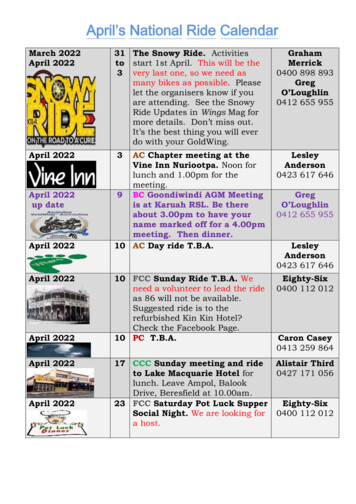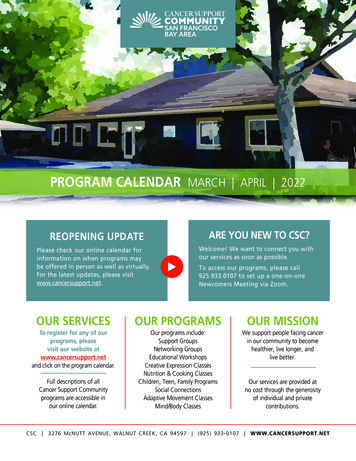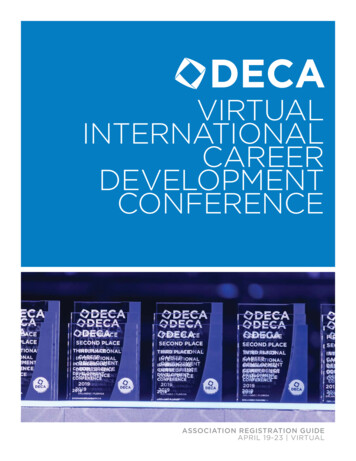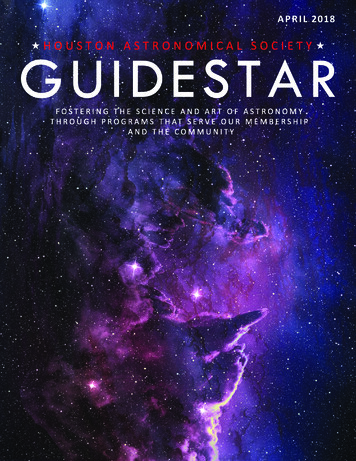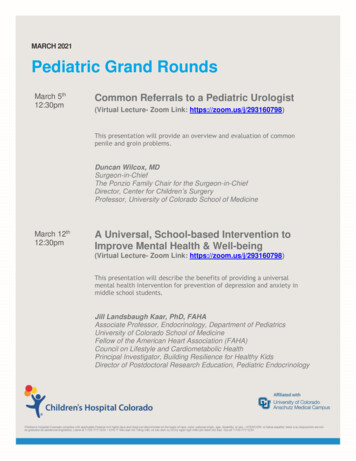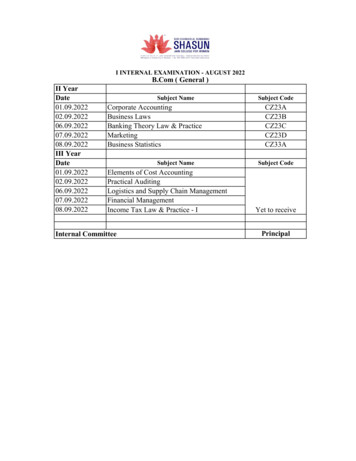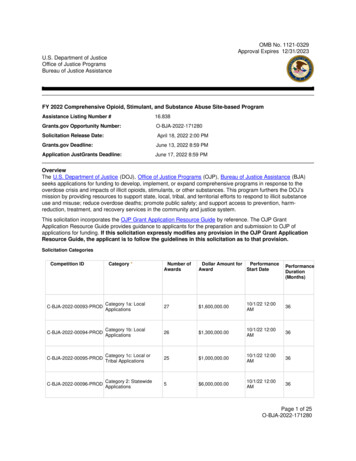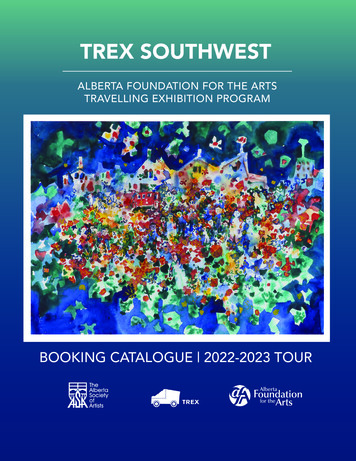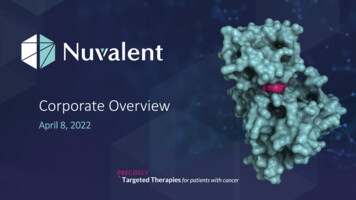
Transcription
Corporate OverviewApril 8, 2022
CAUTIONARY NOTE REGARDING FORWARD-LOOKING STATEMENTSThis document contains forward-looking statements within the meaning of the Private Securities Litigation Reform Act of 1995, as amended, including, without limitation,implied and express statements regarding Nuvalent's strategy, business plans, and focus; the clinical development programs for NVL-520, NVL-655, ALK IXDN compoundresistance mutations and HER2 exon 20 insertions and the timing thereof; the potential clinical effect of NVL-520 and NVL-655; the design and enrollment of the ARROS-1study and the timing thereof; the design and initiation of the ALKOVE-1 Phase 1/2 study and the timing thereof; the potential of Nuvalent's pipeline programs, includingNVL-520 and NVL-655; Nuvalent's research and development programs for the treatment of cancer; risks and uncertainties associated with drug development; capitalallocation; and Nuvalent’s future financial and operating results and its expectations related thereto. The words "may," "might," "will," "could," "would," "should," "expect,""plan," "anticipate," "aim," "goal," "intend," "believe," "expect," "estimate," "seek," "predict," "future," "project," "potential," "continue," "target" or the negative of theseterms and similar words or expressions are intended to identify forward-looking statements, although not all forward-looking statements contain these identifying words.Drug development and commercialization involve a high degree of risk, and only a small number of research and development programs result in commercialization of aproduct. You should not place undue reliance on these statements or the scientific data presented.Any forward-looking statements in this document are based on management’s current expectations and beliefs and are subject to a number of risks, uncertainties, andimportant factors that may cause actual events or results to differ materially from those expressed or implied by any forward-looking statements contained in this pressrelease, including, without limitation, risks associated with: risks that Nuvalent may not fully enroll the ARROS-1 study or it will take longer than expected; unexpectedconcerns that may arise from additional data, analysis, or results obtained during clinical trials; the occurrence of adverse safety events; risks of unexpected costs, delays,or other unexpected hurdles; the impact of COVID-19 on countries or regions in which Nuvalent has operations or does business, as well as on the timing and anticipatedtiming and results of its clinical trials, strategy, and future operations, including the global ARROS-1 study and the planned initiation of the ALKOVE-1 Phase 1/2 study; thetiming and outcome of Nuvalent’s planned interactions with regulatory authorities; and obtaining, maintaining, and protecting its intellectual property. These and otherrisks and uncertainties are described in greater detail in the section entitled “Risk Factors” in the Company’s Annual Report on Form 10-K for the year ended December 31,2021, as well as any subsequent filings with the Securities and Exchange Commission. In addition, any forward-looking statements represent Nuvalent’s views only as ofApril 8, 2022 and should not be relied upon as representing its views as of any subsequent date. Nuvalent explicitly disclaims any obligation to update any forward-lookingstatements.2
Expertise in chemistry andstructure-based drug designdrives wholly-owned pipelineof novel targeted therapies3Our mission is to bringnew medicines topatients with cancerPrecisely designed solutions aiming toovercome limitations of existingtherapies identified through closecollaboration with physician-scientists
Significant pipeline progress and value creation to date:Foundational DiscoveryTransformational Growth 50M Series A External corporate launch Founder and head scientific advisor Matthew Shair, PhD,Professor of Chemistry & Chemical Biology, Harvard University Proprietary technology developed at Nuvalent to overcomedual challenges of kinase resistance and kinase selectivity Parallel lead drug candidates nominated:NVL-520NVL-655ROS1-selective inhibitorALK-selective inhibitor Established discovery team and robust pipeline4 Team expansion to drive transition to a clinical stage company Preclinical product profiles for both NVL-520 and NVL-655presented at AACR & EORTC-NCI-AACR 135M Series B 191M upsized IPO (Nasdaq: NUVL) First patient dosed in ARROS-1, a Phase 1/2clinical trial of NVL-520 for patients with advancedROS1-positive non-small cell lung cancer (NSCLC)and other solid tumors Continued advancement of NVL-655 and discovery pipeline
Year of Operational Execution:Double Down: Discovery & Development Clinical-stage biotech with an active R&D pipeline: Efficient conduct of the Phase 1 portion ofthe ARROS-1 trial for NVL-520 Planned initiation of the ALKOVE-1 Phase 1/2trial in advanced ALK-positive NSCLC andother tumors for NVL-655 Planned portfolio expansion with internallydiscovered novel drug candidates Expected cash runway into 2024 with multipleopportunities for proof-of-concept clinical data5VisionDiscover, Develop & DeliverFully integrated pharmaceutical companywith the goal of translating deep expertise inchemistry & structure-based drug designinto best-in-class small molecule medicinesfor patients with cancer
The Nuvalent TeamSignificant Experience in Drug Discovery, Development and Company BuildingLEADERSHIP TEAMBOARD OF DIRECTORSSCIENTIFIC ADVISORSJames Porter,PhDAlex Balcom,MBA, CPAChristopherTurner, MDEmily Drabant Conley, PhDMatthew Shair, PhDCEO, Federation BioChief ExecutiveOfficerChief FinancialOfficerChief MedicalOfficerGary Gilliland, MD, PhDHead Scientific AdvisorHarvard Professor of Chemistry& Chemical BiologyDeborah Miller,PhD, JDChief LegalOfficerJosh Horan,PhDVP, ChemistryMatthewMetivierVP, HumanResourcesDarlene Noci,ALMSr VP, ProductDevelopment &Regulatory AffairsBenjamin Lane,PhDVP, PharmaceuticalDevelopmentHenry Pelish,PhDVP, BiologyRuth AdamsVP, ClinicalOperationsIndependentAndrew Hack, MD, PhDBain Capital Life SciencesClinical AdvisorUniversity of ColoradoRobert Jackson, MDAlexander Drilon, MDIndependentJessie LinVP, CorporateStrategy & PortfolioManagementJohn Soglia, PhDVP, TranslationalDevelopmentJoseph Pearlberg, MD, PhDClinical AdvisorMemorial Sloan Kettering Cancer CenterDeerfield ManagementAaron Hata, MD, PhDAnna ProtopapasCEO, MersanaTranslational Research AdvisorMass General Cancer CenterJames Porter, PhDPasi Jänne, MD, PhDCEO, NuvalentMatthew Shair, PhDHarvard Professor of Chemistry& Chemical BiologySapna Srivastava, PhDPRIOR FDAAPPROVALEXPERIENCEIndependentCameron Wheeler, PhDDeerfield Management6Ross Camidge, MD, PhDClinical AdvisorDana Farber Cancer InstituteNancy Kohl, PhDTranslational Research AdvisorIndependent ConsultantMichael Meyers, MD, PhDClinical AdvisorCMO, Syndax
Nuvalent is focused on creating preciselytargeted therapies to overcome key limitationsof existing therapies for clinically proven kinasesand renew hope for patients in need Expertise in structure-based drug design to createinnovative small molecules “Threading the needle”: Aim to achieve high affinity fordrug-resistant kinases while avoiding off-target kinases inthe central nervous system (CNS) and in the periphery 7Potential to minimize adverse events AND drivemore durable responses
ORIGINALTUMORDRUG-RESISTANTTUMOR&Mutation in target kinaseconfers resistance toexisting therapyKinaseResistanceEXISTING THERAPYNUVALENT THERAPYEXISTING THERAPYNUVALENT THERAPYStructural innovationsdesigned to overcomedrug-resistance due tokinase mutationsSuccessful inhibition of target kinase8Mutation confersresistanceDesigned to overcomedrug-resistance mutation
NON-SELECTIVE THERAPYSELECTIVE NUVALENTTHERAPYvs.Selective inhibitionpotentially minimizestoxicitiesKinaseSelectivityStructural innovations designedto increase selectivity topotentially minimize therapylimiting adverse events relatedto off-target inhibition ANDdrive more durable responses9TA R G E T K I N A S EINHIBITIONAdverse events due tooff-target inhibitionTA R G E T K I N A S EINHIBITION
NVL-520Next generationROS1-selective inhibitor10ROS1 image source: 4UXL.pdb
ROS1 Receptor Tyrosine KinaseGenomic alterations lead to tumorigenesis and confer treatment resistanceR O S 1 ( U N M U TAT E D )Ligand-dependentROS1 receptor activationRegulatedcell signalingONCOGENIC ROS1 R EARRANGEMENTSS E C O N D A RY R E S I S TA N C E M U TAT I O N SROS1 generearrangemente.g. CD74-ROS1fusionReported secondarymutations mappedon ROS1 kinasedomain in complexwith crizotinib(PDB:3ZBF)Unregulatedcell signalingCell growth, proliferation, and differentiationExcessive cell growth and proliferation leading to tumorigenesis ROS1-deficient mice are viable, with malesinfertile and no detectable abnormalitiesin females In male mice, ligand NELL2 binds ROS1 inepididymis to induce epididymaldifferentiation for sperm maturation In humans, highest expression inepididymis and lung Rearrangements may result in transmembrane orintracellular ROS1 fusions ROS1 fusions have been identified across multiplesolid tumors, including NSCLC (up to 3%) adultglioblastoma (0.5%), pediatric low-grade and highgrade gliomas, spitzoid neoplasms (17%), IMT ( 10%),SGC, PTC, ALCL, SOC, IHCA, cholangiocarcinoma, andgastric and pancreatic adenocarcinoma Kinase domain mutations in ROS1 confer resistanceto approved inhibitors such as crizotinib “Solvent front” mutation (e.g. G2032R, D2033N) inthe solvent-exposed region are the most common,and cause steric hinderance to drug binding Additional mutations such as S1986Y/F and“gatekeeper” mutation L2026M have beenobservedSources: Drilon et. al. Nat Rev Clin Oncol 2021; Jordan et al., Cancer Discovery. 2017; Lin and Shaw 2017 JTO; The Human Protein Atlas; Structure image from Lin and Shaw 2017 JTOAbbreviations: ALCL: Anaplastic large cell lymphoma; IHCA: Inflammatory hepatocellular adenoma; IMT: Inflammatory myofibroblastic tumor; SGC: Salivary gland carcinoma; PTC: Papillary thyroid carcinoma; ROS1: c-rosoncogene 1; SOC: Serous ovarian carcinoma (SOC); TRK: tropomyosin receptor kinase11
ROS1-positive NSCLC Market OverviewEmerging resistance mutations and increasing CNS involvement limit utility of approved therapiesL I N E O F T H E R A PYKinaseinhibitor naïveROS1 NSCLC1 prior kinaseinhibitorROS1 NSCLCS U B - PO P UL AT IO NWild-typekinase domainI N C I D EN C E ( U S ) 3,000 – 4,500newly diagnosedpatients / year 41%OF(2021) 20 – 40%Entrectinib 30 – 55%G2032RmutationS TA N DA R DCrizotinibNon-G2032RmutationSources: Lin et al., J Thorac Oncol 2017; Gainor et al, JCO Precision Oncol 2017; Ou and Zhu Lung Cancer 2019; Patil et al, JTO 201812C N S D I S EA S ECARE
NVL-520Differentiated Product Candidate for ROS1-positive NSCLC PatientsNUVALENT IN VITRO PRECLINICAL CHARACTERIZATIONN VL-520FDA APPROVEDC R I Z OT I N I BINVESTIGATIONALInvestigationalROS1-selective inhibitorLO R L AT I N I BDual ALK/ROS1ENTRECTINIBDual TRK/ROS1Dual ALK/ROS1R E P OT R E C T I N I BDual TRK/ROS1W I L D T Y P E RO S 1FUSION ACTIVITYG 2 0 3 2 R RO S 1ACTIVITYTRKBS PA R I N GCNSACTIVITYYesYesYesPredicted based on preclinicalexperimentsYesNoNoYesNoNoYesNoNoLimited selectivity at dosedeveloped for ALK GRYesNoNot in FDA approved labelYesIn FDA labelYesIn FDA label for ALK NSCLCYesYesYesNoInvestigational: CNS activityreported in preliminary Phase 1dataNo head-to-head clinical studies have been conducted for currently approved or investigational therapies versus NVL-520. Clinical investigation of NVL-520 is ongoing.Other than as indicated in the CNS Activity column, data in table above is based on preclinical experiments conducted by Nuvalent. Characterization of CNS activity for each ROS1 inhibitor is basedon FDA labels and/or available clinical and preclinical data independently generated by each sponsor and not based on any preclinical experiments conducted by Nuvalent.13
T R K I N H I B I T I O N S A F E T Y I M P L I C AT I O N SOvercoming KinaseSelectivity in NSCLCImpairments in memory, learning andnociceptionTRKBROS1 and ALK both share strongstructural similarities to TRKBrain penetration is needed toaddress associated CNS diseasein ROS1 and ALK driven cancersInhibitors must be highlyselective to avoid CNS toxicitiesfrom off-target inhibition of TRKDevelopment of obesity caused byhyperphagia and hyperdipsiaImpairment of motor neuron afferents andloss of dorsal root ganglia neuronsTRKCDefect in proprioceptionTRKACongenital insensitivity topain with anhidrosis (CIPA)Severe sensory andsympathetic neuropathiesSources: Adapted from Cocco, Scaltriti and Drilon Nat Rev Clin Oncol 201814
N V L - 5 2 0 R O S 1 - S E L E C T I V E TA R G E T P R O D U C T P R O F I L EWild-type ROS1 fusionsROS1 ACTIVITYEmergent ROS1 resistance mutations:G2032R, D2033N, L2026M, S1986Y/Fvs. TRK, to minimize CNS adverse eventsSELECTIVITYvs. Other off-targets kinasesCNS ACTIVITY15Optimize for brain penetrance to improvetreatment options for patients with brainmetastasesNVL-520ROS1 NSCLCDevelopment Strategy
Preclinical NVL-520 activity against ROS1Wild-type ROS1 Fusions, in vitro and in vivo NSCLC modelsNVL-520ROS1-selectiveTarget Product Profilein vitroin vivoIC50 cell viability assayBa/F3 CD74-ROS1Wild-typeROS1 fusionsWILD-TYPEROS1 FUSIONROS1 ACTIVITYResistancemutationsTRKSELECTIVITYOther offtargetsCNS ACTIVITYBrainpenetrationSDC4-ROS1 wild-type NSCLC PDX modelNVL-520 was well-tolerated in all in vivo studiesNVL-5201.2 nMC R I Z OT I N I B40 nMENTRECTINIB23 nML O R L AT I N I B1.3 nMR E P OT R E C T I N I B4.4 nMTumorvolume(mm3 )204810245122561286432168BID PO, n 540714vehicle0.04 mg/kg *0.2 mg/kg *1 mg/kg *2128Days on treatment*p 0.0001 vs. vehicle by 2-way repeat measure ANOVA with Geisser-Greenhouse correction followed by Dunnett’s multiple comparison test16Experiments not powered to determine the statistical significance of differences in measurements between any of the inhibitors tested. No head-to-head clinical studieshave been conducted for currently approved or investigational therapies versus NVL-520. Clinical investigation of NVL-520 is ongoing.Source: Pelish, H.E., Tangpeerachaikul, A., Kohl, N.E., Shair, M.D., Porter, J.R., and Horan, J.C. AACR Conference 2021
Preclinical NVL-520 activity against ROS1Clinically Relevant Drug-Resistant Mutations, in vitro and in vivo ROS1 fusion NSCLC modelsin vitroNVL-520ROS1-selectiveTarget Product ProfileWild-typeROS1 fusionsIC50 cell viability INIBREPOTRECTINIBMGH9018-1 PDC, CD74-ROS1G2032R4.7 nM1000 nM590 nM460 nM30 nMBa/F3 CD74-ROS1G2032R3.5 nM960 nM1,500 nM300 nM25 nMS1986F 0.58 nM39 nM26 nM 0.27 nM0.84 nML2026M1.5 nM110 nM41 nM0.77 nM3.3 nMD2033N1.0 nM77 nM79 nM0.44 nM2.5 nMBa/F3 CD74-ROS1ROS1 ACTIVITYResistancemutationsTRKIC50: 0-49 nM; 50 - 499 nM; 500 nMin vivoSELECTIVITYCNS ACTIVITY17Other offtargetsCD74-ROS1 G2032RNSCLC PDX modelBrainpenetrationNVL-520 was welltolerated in all in vivostudies20481024512Tumor 256volume 128(mm3 )643216BID PO, n 580720481024vehiclevehicle5122561281 mg/kg5 mg/kgNVL-520 ‡64321621Repotrectinib*not toleratedBID PO, n 581415 mg/kg75 mg/kg*071421Days on treatmentDays on treatmentPDC: Patient Derived Cell-line‡ p 0.0001 for both doses of NVL-520 vs. vehicle by one-way ANOVA followed by Dunnett’s multiple comparisons testExperiments not powered to determine the statistical significance of differences in measurements between any of the inhibitors tested. No head-to-head clinical studieshave been conducted for currently approved or investigational therapies versus NVL-520. Clinical investigation of NVL-520 is ongoing.Sources: Pelish, H.E., Tangpeerachaikul, A., Kohl, N.E., Shair, M.D., Porter, J.R., and Horan, J.C. AACR Conference 2021;Deshpande, A., Yoda, S., Tangpeerachaikul, A., Kohl, N.E., Horan, J.C., Hata, A.N., and Pelish, H.E. EORTC-NCI-AACR 2021
Preclinical ability of NVL-520 to avoid off-target TRK inhibitionPotential for Differentiation vs CNS Active Dual TRK/ROS1 Inhibitors Entrectinib and RepotrectinibMore selectivefor ROS1 variantNVL-520ROS1-selectiveTarget Product Profile1000ROS1 fusion variants:730xwt: wild-typeGR: G2032R240x100Wild-typeROS1 fusionsROS1 ACTIVITYRelative selectivityfor ROS1 vs. TRKBResistancemutationsTRKSELECTIVITYTRK selectivity IC50 (Ba/F3 7xwt wild-typeGR G2032RMore selectivefor TRKBROS1 ROS1wtGR1ROS1 ROS1wtGRROS1CNS ACTIVITYROS1GRIC50 (pTRKB)Other -520NVL-520CrizotinibEntrectinibRepotrectinibTRKB activity as measured by a cell TRKB phosphorylation assay. Phosphorylation of intracellular TRKB was measured in Ba/F3 cells expressing full-length TRKB and stimulated by BDNF usingthe phospho-TRK AlphaLISA kit. TRKB activity was also measured in additional internal assays, where results were consistent in relative terms. Compounds that showed greater selectivity inone assay also showed greater selectivity in all other investigated assays.Experiments not powered to determine the statistical significance of differences in measurements between any of the inhibitors tested. No head-to-headclinical studies have been conducted for currently approved or investigational therapies versus NVL-520. Clinical investigation of NVL-520 is ongoing.Source: Tangpeerachaikul, A., Horan, J.C, and Pelish, H.E. AACR-NCI-EORTC 2021
Selectivity of NVL-520 for ROS1 over other kinasesPreclinical Kinome Selectivity Screen: 335 Wild Type KinasesALKNVL-520ROS1-selectiveTarget Product ProfileWild-typeROS1 fusionsROS1 ACTIVITYResistancemutationsTRKS ELECTIVITY I NDEXRelative to ROS1-wt1xKINASEROS11 – 10xALK10 – 50xLTK, FAK, PYK2, TRKB, FER 50x328 other kinasesSELECTIVITYOther offtargetsCNS ACTIVITY19BrainpenetrationSelectivity index IC50 (kinase of interest)IC50 (ROS1 wild-type)Eid S. et al. Bioinformatics 2017Illustration reproduced courtesy of Cell Signaling Technologies, Inc. (www.cellsignal.com)Source: Pelish, H.E., Tangpeerachaikul, A., Kohl, N.E., Shair, M.D., Porter, J.R., and Horan, J.C. AACR Conference 2021ROS1
Preclinical brain penetrance of NVL-520Pharmacokinetic Data Similar to Preclinical Observations for LorlatinibNVL-520ROS1-selectiveTarget Product ProfileWild-typeROS1 fusionsROS1 ACTIVITYResistancemutationsTRKSELECTIVITYOther offtargetsCNS ACTIVITY20Brainpenetrationin vivoWistar Han ratsDose: 10 mg/kg QDx1 PO1h .10.20.0NVL-520LorlatinibExperiments not powered to determine the statistical significance of differences in measurements between any of the inhibitors tested. No head-to-head clinical studieshave been conducted for currently approved or investigational therapies versus NVL-520. Clinical investigation of NVL-520 is ongoing.Source: Data on file
Preclinical CNS anti-tumor activity of NVL-520Reduction of Brain Tumors and Extended Median Survival in a Preclinical ModelvehicleNVL-520ROS1-selectiveTarget Product ProfileWild-typeROS1 fusions0TreatmentDayNVL-520 *2 mg/kg10016ROS1 NVL-520 2 mg/kg BID (PO)SELECTIVITYOther offtargetsCNS ACTIVITYBrainpenetration000 7 14 21 28 35 42 49 56 63TreatmentDayDays on treatment1621Ba/F3 CD74-ROS1 G2032R stably expressing luciferase* Median survival was 16.5 days for vehicle group and 61 days for the NVL-520-treated group, corresponding to a significant median overall survival extension 3.7-fold(p-value 0.0001, log-rank Mantel-Cox test).Source: Pelish, H.E., Tangpeerachaikul, A., Kohl, N.E., Shair, M.D., Porter, J.R., and Horan, J.C. AACR Conference 2021
C O UN T RYI N S T IT UT I O N*MGH (Boston, MA)MDACC (Houston, TX)MSKCC (New York, NY)First-in-Human (FIH) Phase 1/2 Clinical Trial ofNVL-520 in Advanced ROS1-Positive NSCLCand Other Solid Tumors (NCT05118789) Sites selected to target global experts in TKI NSCLC earlydevelopment (ROS1 and ALK Programs)University of Colorado (Denver, CO)Sarah Cannon (Nashville, TN)UCI Medical Center (Irvine, CA)Vall d-Hebron (Barcelona) Phase 1 portion of ARROS-1 open and actively enrolling Ongoing site expansion in the US and EuropeGustave-Roussy (Paris)UMCG (Groningen)* Non-exhaustive list of planned and active sites.Please refer to clinicaltrials.gov for the most up to date list of sites.22
First-in-Human Phase 1/2 Clinical Trial of NVL-520 in AdvancedROS1-Positive NSCLC and Other Solid Tumors (NCT05118789)Phase 2 Cohorts Designed to Support Potential Registration in Kinase Inhibitor Naive or Previously Treated ROS1-positive NSCLCPhase 2Phase 1COHORT150 mg QD125 mg QD100 mg QDTUMOR TYPEPRIORROS1 TKIPRIORCHEMO/I-O**2aROS1-positive NSCLCNaive 12bROS1-positive NSCLC1*NaiveSubset analysis forG2032R2cROS1-positive NSCLC1*1Subset analysis forG2032R2dROS1-positive NSCLC2 1Subset analysis forG2032R2eAny ROS1-positiveSolid Tumor***AnyAnyExploratory Cohort75 mg QD50 mg QD25 mg QDPURPOSE Safety / Tolerability Determine/Confirm RP2DCohorts 2a, 2b, 2c, and 2d were designed to support potential registration*Either crizotinib or entrectinib; ** Platinum-based chemotherapy immunotherapy; *** Includes NSCLC who do not qualify for any of the other cohortsI-O: Immunotherapy; RP2D: Recommended Phase 2 Dose; TKI: Tyrosine Kinase Inhibitor23DETAIL
NVL-655Next generationALK-selective inhibitor24
Anaplastic Lymphoma Kinase (ALK)Genomic alterations lead to tumorigenesis and treatment resistanceA L K ( U N M U TAT E D )Ligand-dependentALK receptor activationRegulatedcell signalingO N C O G E N I C A L K A LT E R AT I O N SALK generearrangemente.g. EML4-ALKfusionUnregulatedcell signalingS E C O N D A RY R E S I S TA N C E M U TAT I O N SActivatingpointmutationsCell growth, proliferation, and differentiationExcessive cell growth and proliferation leading to tumorigenesis Limited data is availablecharacterizing function and ligandstimulated activation Expression pattern in humanssuggests a role in early nervoussystem development, with lowexpression in adults Knockout mice are viable Activating ALK gene rearrangements and pointmutations have been reported in multiple solid andhematologic tumor types ALK rearrangements define a distinct molecularsubtype of NSCLC, occurring in 5% of NSCLC caseswith EML4 being the most common fusion partner ALK tyrosine kinase inhibitors (TKIs) haverevolutionized care of ALK-positive NSCLC patients,with multiple generations of inhibitors now availableSources: Palmer et. al. Biochem J 2009; Hallberg & Palmer Nat Rev Cancer 2013; Hallberg & Palmer Ann of Oncol 2016; Gainor et. al. Cancer Discov 2016;25Reported secondarymutations mappedon ALK kinasedomain in complexwith crizotinib(PDB:2XP2) Growing clinical evidence suggests that differentresistance mutation patterns may emerge depending onthe ALK TKI used and line of therapy “Solvent front” mutations (e.g. G1202R, D1203N) in thesolvent-exposed region cause steric hinderance to drugbinding Compound mutations (“solvent front” mutation G1202R “gatekeeper” mutation L1196M) have been observedupon sequential alectinib/lorlatinib treatment
ALK-Positive NSCLC Market OverviewEmerging Resistance Mutations and Increasing CNS Involvement Limit Utility of Approved TherapiesL I N E O F T H E R A PYKinaseinhibitor naïveALK NSCLC1 prior kinaseinhibitorALK NSCLCS U B - PO P UL AT IO NI N C I D EN C E ( U S )C N S D I S EA S EOFCARE(2021)BrigatinibWild-typekinase domain 9,000 – 18,000 newlydiagnosed patients /year 30 – ibG1202R 35%I1171N/S/T 15 – 30% 60%OtherG1202R/L1196M2 prior kinaseinhibitorsG1202R/G1269AALK NSCLCI1171N / D1203NG1202R/L1198F 60%OtherSources: Ou and Zhu Lung Cancer 2019; Kris et. al. JAMA 2014; Shaw and Engelman J Clin Onc 2013; Noé et. al. J Thor Onc 2019; Peters et. al. NEJM 2017; Shaw et. al.Lancet Onc 2017; Dagogo-Jack et. al. Clin Cancer Res 201926S TA N DA R DLorlatinib
NVL-655Differentiated Product Candidate for ALK-positive NSCLC patientsNUVALENT IN VITRO PRECLINICAL CHARACTERIZATIONWILD-TYPE ALKFUSION ACTIVITYG1202R ALKACTIVITYGRLM, GRGA & GRLFALK elective inhibitorYesYesYesYesPredicted based on preclinicalexperimentsC R I Z OT I N I BYesNoNoNoCERITINIBYesNoNoYesALECTINIBYesNoNoYesB R I G AT I N I BYesNoNoYesL O R L AT I N I BYesYesNoLimited selectivity at dosedeveloped for ALK GRFDA APPROVEDN V L - 655NoYesNoNot in FDA labelYesIn FDA labelYesIn FDA labelYesIn FDA labelYesIn FDA labelNo head-to-head clinical studies have been conducted for currently approved or investigational therapies versus NVL-655. No clinical studies have been conducted with NVL-655.Other than as indicated in the CNS Activity column, data in table above is based on preclinical experiments conducted by Nuvalent. Characterization of CNS activity for each ALK inhibitor isbased on FDA labels and/or available clinical and preclinical data independently generated by each sponsor and not based on any preclinical experiments conducted by Nuvalent.GR: G1202R; LM: L1196M; GA: G1269A; LF: L1198F27
N V L - 6 5 5 A L K - S E L E C T I V E TA R G E T P R O D U C T P R O F I L EWild-type ALK fusionsACTIVITYEmergent ALK resistance mutations:G1202R single and compound mutations(G1202R/L1196M, G1202R/G1269A,G1202R/L1198F)vs. TRK, to minimize CNS adverse eventsSELECTIVITYvs. Other off-target kinasesCNS ACTIVITY28Optimize for brain penetrance to improvetreatment options for patients with brainmetastasesNVL-655ALK NSCLCDevelopment Strategy
Preclinical NVL-655 activity against ALKWild-type ALK Fusions, in vitro NSCLC modelsNVL-655ALK-selectiveTarget Product Profilein vitroWild-typeALK fusionALK ACTIVITYResistancemutationsTRKSELECTIVITYOther offtargetsCNS ACTIVITY29IC50 cell viability assay (nM)NVL-655C R I Z OT I N I BCERITINIBALECTINIBB R I G AT I N I BL O R L AT I N I BNCI-H2228 (EML4-ALK v3)0.70 nM90 nM55 nM13 nM13 nM 1.1 nMNCI-H3122 (EML4-ALK v1)2.0 nM180 nM48 nM22 nM22 nM3.5 nMBa/F3 EML4-ALK v11.6 nM270 nM90 nM25 nM42 nM4.2 nMIC50: 0-49 nM; 50 - 499 nM; 500 nMBrainpenetrationExperiments not powered to determine the statistical significance of differences in measurements between any of the inhibitors tested. No head-to-head clinical studieshave been conducted for currently approved therapies versus NVL-655. No clinical studies have been conducted with NVL-655.Source: Pelish, H.E., Tangpeerachaikul, A., Kohl, N.E., Shair, M.D., Porter, J.R., and Horan, J.C. AACR Conference 2021
Preclinical NVL-655 activity against ALKClinically Relevant Drug-Resistant G1202R Mutations, in vitro and in vivo ALK fusion NSCLC modelsNVL-655in vitroALK-selectiveTarget Product ProfileIC50 cell viability assay (nM)NVL-655C R I Z OT I N I BCERITINIBALECTINIBB R I G AT I N I BL O R L AT I N I BG1202R 0.73 nM950 nM570 nM1600 nM400 nM120 nMWild-typeALK fusionG1202R/L1196M7.0 nM1500 nM1400 nM2200 nM820 nM3900 nMG1202R/G1269A3.0 nM1100 nM350 nM1300 nM240 nM970 nMResistancemutationsG1202R/L1198F2.0 nM170 nM1300 nM2200 nM470 nM720 nMALK ACTIVITYTRKIC50: 0-49 nM; 50 - 499 nM; 500 nMin vivoSELECTIVITYOther offtargetsCNS ACTIVITYBrainpenetrationBa/F3 EML4-ALK v1G1202R/L1196MCDX modelsNVL-655 waswell-tolerated inall in vivo studies2048vehicle10240.3 mg/kg512Tumor 256NVL-655volume 1283(mm )641.5 mg/kg *3216BID PO, n 580714Days on treatment2048vehicle102410 mg/kg512Lorlatinib256128643216BID PO, n 580714Days on treatment*p 0.0001 vs. vehicle by two-way repeat measures ANOVA followed by Tukeys post hoc comparisons of the means30Experiments not powered to determine the statistical significance of differences in measurements between any of the inhibitors tested. No head-to-headclinical studies have been conducted for currently approved therapies versus NVL-655. No clinical studies have been conducted with NVL-655.Source: Pelish, H.E., Tangpeerachaikul, A., Kohl, N.E., Shair, M.D., Porter, J.R., and Horan, J.C. AACR Conference 2021
Preclinical NVL-655 activity against ALKClinically Relevant Drug-Resistant non-G1202R Mutations, in vitro and in vivo ALK fusion NSCLC modelsin vitroNVL-655ALK-selectiveTarget Product ProfileWild-typeALK fusionIC50 cell viability assay (nM)NVL-655C R I Z OT I N I BCERITINIBALECTINIBB R I G AT I N I BL O R L AT I N I BL1196M29 nM1100 nM79 nM120 nM100 nM86 nMI1171N27 nM320 nM140 nM570 nM30 nM59 nMALK ACTIVITYIC50: 0-49 nM; 50 - 499 nM; 500 nMResistancemutationsTRKSELECTIVITYOther offtargetsCNS ACTIVITYBrainpenetrationBa/F3 EML4-ALK v1I1171N CDX modelNVL-655 waswell-tolerated in allin vivo studies20482048in vivovehicle1024Tumorvolume(mm3)5122561286432BID PO, n 50vehicle10245121.5 mg/kg*2564.5 mg/kg7.5 mg/kg**NVL-655128714Days on treatment6432BID PO, n 50Lorlatinib5 mg/kg *714Days on treatment*p 0.0001 vs. vehicle by two-way repeat measures ANOVA followed by Tukeys post hoc comparisons of the means31Experiments not powered to determine the statistical significance of differences in measurements between any of the inhibitors tested. No head-to-head clinical studieshave been conducted for currently approved therapies versus NVL-655. No clinical studies have been conducted with NVL-655.Source: Tangpeerachaikul, A., Deshpande, A., Kohl, N.E., Horan, J.C, and Pelish, H.E. AACR-NCI-EORTC 2021
Preclinical ability of NVL-655 to avoid off-target TRK inhibitionPotential for Differentiation vs CNS Active ALK Inhibitor LorlatinibNVL-655ALK fusion variants:More selectivefor ALK variantALK-selectiveTarget Product Profile1000GRLM: G1202R/L1196M870xALK ACTIVITYResistancemutationsTRKSELECTIVITYOther offtargetsCNS ACTIVITY32Brainpenetration TRK selectivityIC50 (pTRKB)ALKMore selectivefor TRKB200x9x101.4xALKGRALKGRLMALKGRGAALKALKGRLM GRGAALKwtALKGRALKALKGRLM GRGA1ALKwtIC50 (Ba/F3 EML4-ALK)wt wild-typeGR G1202RLM L1196MGA G1269AGRGA: G1202R/G1269A91x100Relative selectivityfor ALK vs. TRK
concerns that may arise from additional data, analysis, or results obtained during clinical trials; the occurrence of adversesafety events; risks of unexpected costs, delays, . kinase domain 3,000 -4,500 newly diagnosed patients / year 20 -40% 1 prior kinase inhibitor ROS1 NSCLC Non-G2032R mutation 30 -55% G2032R mutation 41%
